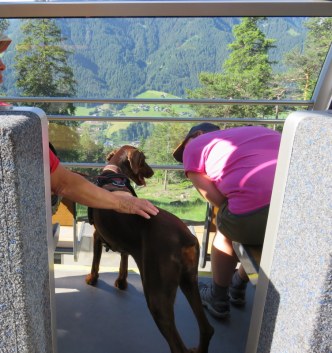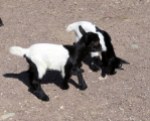15 September 2019.
Sometimes you just need to escape even while you are away. Rick Steves calls this a “vacation from your vacation.” While we aren’t really in need of further relaxation, we do like the atmosphere of the Alpe di Siusi and it has become a tradition for us to pass a couple of nights there and be able to hike in the mornings without worrying about an early bus from Ortisei or racing to beat the last gondola down at 17:30. It’s a looonnggg walk if you miss the last ride.

The gondola up to — and down from — the Alpe di Siusi. It only runs until 17:30 so don’t miss the last ride!
We are based for 2 1/2 weeks at the incredible Residence Astoria, our home in the Val Gardena the past four years. (See Training cats from 2016.) Taking only our backpacks with a change of clothing, we headed to Hotel Saltria for two nights, partaking of their half-pension plan and enjoying the convenience of being right there in the Alpe di Siusi for an early morning hike as recommended in our book, Walking in Italy’s Val Gardena. It’s good to travel light as this journey takes 3 buses and a gondola over the course of 90 minutes. Not fun with heavy luggage.

The Hotel Saltria is a larger property, yet retains an intimacy
Arriving at the hotel, we had time for an hour’s walk in the afternoon sun through mountain meadows, then a shower before dinner. No extended Italian eating hours here! Dinner is from 19:00-20:30 and almost all of the guests arrived in the first 15 minutes. (We did see one couple, clearly new to the concept and not Italian nor German, waltz in at 20:28 and they were seated and served. I think they got the dregs of what was left, though.)

A rifugio on the Panorama hike. The pond is used for fire-fighting (rare) and snow-making in ski season.
The next morning we were on the trail before 10:00 and took what may be our new favorite hike in the Alpe di Siusi, Panorama to Zallinger. (I’ll be writing that in detail for another post.) This was a long-ish one. Leaving the hotel a few minutes before 9:00, we did not return until 15:30 what with transportation, a coffee stop, a lunch break, and a 10 km walk. If we had tried to do this from Ortisei, we would have been gone from 8:00-18:00.
It was so nice to be catered to for breakfast and dinner. No shopping (which we do daily when we are in a self-catered situation), no cooking or food prep of any type. We just showed up and let the hotel staff take care of everything.

The dining room at Saltria. There were people of all ages: young couples with new babies, young couples alone, multi-generational groups, and people like us.
Breakfast was spread across a room bigger than our home living, dining, and kitchen areas combined! Set in a huge “E” shape, were baskets of various rolls and pastries, 8 types of preserves, 4 kinds of honey including one that was still in the comb, fruits, fruit salad, yoghurt, soft boiled eggs, a vegetable juicer, salad ingredients, 4 kinds of sliced meats, and at least 4 types of cheese. Beverages were on a separate buffet and the waitress made cappuccino, espresso, or “German” coffee to order.
This part of Italy is so Austrian that the first words out of anyone’s mouth are generally in German. In fact, this past week one of the German-language newspapers of the Südtirol expressed sadness on the 100th anniversary of the annexation by the Kingdom of Italy in 1919. Memories are long. So we were offered “German” coffee whereas in most of Italy we would have been asked if we wanted “American” coffee.
German is more prevalent in the Alpe di Siusi than it is even in the valley. A couple of our servers had trouble with Italian. One stumbled over the number 6 (sei in Italian) until I used the German word sechs. Some transactions became amusing mixtures: I told them I wanted my coffee senza milch. That high-school German comes back on occasion.

A sampling of the many vegetables available every night.
At the hotel, none of the food on the menus was described in English. Our evening meals — five courses if you wanted to eat that much — were described in Italian and German and the cuisine was decidedly fusion. Pasta or prosciutto and melon for a first course followed by roasted veal and a beetroot/potato puree. Or a cheese strudel as a starter with mountain lake fish on a bed of leeks with lardo. (Lardo is what it sounds like, though quite refined, a Tuscan specialty.) Like I said, fusion, or as our Italian friend would say, contaminated (contaminazione in Italian is a little pejorative, but serves as a false cognate in this case).
After our long day hike, we could have refreshed in the indoor-outdoor pool or worked on our skin cancer, but we retreated to a pre-dinner shower and coffee on the terrace overlooking the magnificent peaks. Just as the sun was setting, we headed to dinner, now greeted by a huge salad and vegetable buffet spread over the enormous “E” that once held breakfast. Perfectly sauteed artichokes, two types of asparagus, grilled peppers and eggplant, marinated mushrooms, more salad ingredients than the farmers’ market, and a cheeseboard.

My primo one night, pasta with smoked salmon. Sensibly small portion as there was more to come.
That was the first course. After that, there were soup, a primo, a secondo, and dessert, plus (more) cheese and fruit. We confined ourselves to three courses (no soup nor dessert) but indulged in a fine and reasonably-priced wine list.
My middle-of-the-night trip to the bagno was blessed with the lovely sight of the great mountain peaks bathed in moonlight. That alone was worth getting up for at midnight.
Travelers often complain about “touristy” areas and that so many places are over-crowded, or that they encounter too many Americans carrying Rick Steves’ guidebooks. If one wants to have an experience unlike any you are likely to have in North America, this is a fine place to add to an itinerary.

Just starting out on the Panorama hike. Perfect day!
Tags: Alpe di Siusi, dolomites, Hiking, ortisei, Val Gardenia
























































